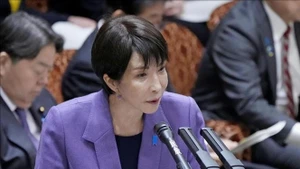Existing danger
According to the United Nations (UN), the world will witness a sharp increase in the number of aging populations in the coming decades. Many countries have been facing this situation due to the continuous decline in birth rates and increase in life expectancy. The UN said the share of the world's population aged 65 years or above is projected to rise from 10% in 2022 to 16% in 2050.
Japan is one of the countries with the highest percentage of an aging population in the world. According to data released by the Ministry of Internal Affairs and Communications of Japan, people aged over 65 make up about 29% of the country's total population, the highest level since 1994.
It is expected that Japan will record new births below 800,000 per year for the first time in 2022, the lowest level since the country started population surveys. Japan's Chief Cabinet Secretary Hirokazu Matsuno called it a "critical situation".
Meanwhile, Professor Yu Shibata from the University of Tokyo said the improvement of the low birth rate is a big challenge, especially in the context of the economic situation of the world in general and Japan in particular, experiencing many difficulties that have directly affected the birth plans of many families.
Not only Japan, but many countries also face the same situation. In the Republic of Korea (RoK), the low birth rate is a headache for policymakers. The total fertility rate, the average number of children born to a woman during her reproductive years, declined for the sixth straight year and is now at a record low of 0.81.
President Yoon Suk Yeol stressed that over the past 16 years, the RoK has spent more than 200 billion USD to turn the situation around, but the birth rate has still dropped sharply. Statistics Korea predicted that they will become the country with the oldest population in the world by 2044, when the number of people aged over 65 may account for 36.7% of the population.
In Europe, the proportion of elderly people in Italy continued to increase as the average age was raised from 43 to 46 years. The Italian National Institute of Statistics said the country's population could shrink by nearly 20% over the next five decades due to a falling birth rate.
The worrying situation mentioned above has negatively affected the economies, while posing a difficult problem for countries in maintaining the pension system, taking care of the elderly and compensating for the number of unemployed workers. The workforce is one of the keys to helping governments boost economic growth, analysts said.
However, the aging population has made it difficult for many countries to meet the labour demand of their economies. The proportion of Japan's population of working age (between 15 and 64 years old) is currently at a record low, accounting for only 58.99%.
Meanwhile, in the RoK, this ratio is likely to fall from 71% in 2022 to 46.1% in 2070. Economist Shruti Singh from the Organisation for Economic Co-operation and Development (OECD) stressed that, if the countries do not act quickly, the decline in the share of the working-age population can delay economic growth.
In addition, population aging also increases the burden on social security programmes in these countries. Japan is struggling to cover the growing social security costs due to the high number of elderly. The current fiscal budget estimate showed that the cost of care for the elderly in Japan is close to 17 trillion yen.
Meanwhile, in the RoK, which has the fastest aging population in the world, about 33.1% of people aged from 70 to 74 are still working, topping the OECD in terms of employment rates for this age group, much higher than the OECD average of 15.2%.
Efforts in adaptation
To overcome the rapidly aging population, the countries have carried out many drastic measures over recent years. Recently, the Japanese Government has adjusted the social insurance structure towards increasing the support for childbirth and the premium rate of people over 75 years old, to reduce the burden on the labour force. Accordingly, the lump-sum birth and childcare allowance will increase to 500,000 yen instead of the current 420,000 yen. During a meeting in early December, Prime Minister Kishida Fumio also confirmed an increase in the size of the budget for children.
The RoK has also just approved the Fourth Mid-to-Long Term Basic Plan for Childcare during the 2023-2027 period, aiming to expand policies to support childcare and increase the birth rate.
Under the new plan, couples in the RoK raising children under the age of 1 will receive 700,000 won a month, more than double the current level. These support packages will be included in the parents' salary system. The new support will be applied from January 1, 2023.
President Yoon Suk Yeol emphasised that the RoK needs to comprehensively reform policies to find solutions to reverse population decline and prepare for the age of people's life expectancy to reach 100.
Meanwhile, to fill the gap caused by a severe labour shortage, many European countries have relaxed immigration conditions and increased wages and benefits to attract foreign workers.
Recently, the German government has agreed on a plan to reform immigration laws in the context of the leading country of the European Union (EU), seeking to open the job market to non-EU workers. German Chancellor Olaf Scholz stressed that Germany should attract more foreign workers and create better working conditions for women and elderly people, to avoid shortages of workers and avoid a crisis in the pension system in the near future.
In addition to opening the door to welcoming migrant workers, analysts said that the countries should continue to adjust policies to create better working opportunities for the aging population.
According to the OECD, due to advances in healthcare around the world, people's average life expectancy and the trend of "healthy old age" are increasing. Professor Sarah Harper from the University of Oxford stressed, that most educated people aged over 60 can contribute to the economy.
Therefore, besides solutions to boost the birth rate, the countries actively adapt to the aging population. If it is possible to promote the contribution of the elderly to socio-economic development, the burden on the aging population will be reduced.
Analysts said that population aging is both a development achievement and poses great challenges to development. Finding a solution to this difficult problem will contribute to helping countries achieve sustainable socio-economic development goals.
















